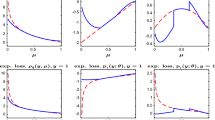Abstract
The occurrences of instantaneous failures, nearly instantaneous failures and early failures are natural in many life testing experiments. They are generally called Inliers, which appears to be inconsistent with the remaining data set. The inliers are either the resultant of sudden changes/failures usually encountered in life testing, financial, clinical trial and many other studies. To accommodate such instances the failure time distributions are modified by defining as those observations which are very small compared to the other positive observations. In this paper, we unify all the three types of failures into one model and study some inferences on the model parameters. The detection of inliers is done for single and multiple inliers using various procedures. A real life application is also discussed.
Similar content being viewed by others
References
Amutha R, Porchelvan P (2009) Estimation of surface run-off in Malttar sub-watershed using SCS-CN method. J Indian Soc Remote Sens 37:291–304
Chaturvedi A, Sharma V (2008) Bayesian life test planning for a family of lifetime distributions: some approximate solutions. Journal of Probability and Statistical Science
Gnedenko BV, Belyayev YK, Solovyev AD (1968) Mathematical models of reliability. Academic Press, New York
Johnson NL, Kotz S, Balakrishnan N (1994) Continuous univariate distributions, vol 1. Wiley, New York
Kale BK, Muralidharan K (2000) Optimal estimating equations in mixture distributions accommodating instantaneous or early failures. J Indian Stat Assoc 38:317–329
Kale BK, Muralidharan K (2006) Maximum likelihood estimation in presence of Inliers. J Indian Soc Prob Stat 10:65–80
Lai CD, Khoo MBC, Muralidharan K, Xie M (2007) Weibull model allowing nearly instantaneous failures. J Appl Math Decis Sci 90842:11 pages
Lawless JF (1982) Statistical models for life time data. Wiley, New York
Mann NR, Schafer RE, Singpurwala NZ (1974) Methods for statistical analysis of reliability and life data. Wiley, New York
Muralidharan K (2010) Inlier prone models: a review. ProbStat Forum 3:38–51
Muralidharan K (2013) Inferences on inliers in Rayleigh distribution. METRON. doi:10.1007/s40300-013-0020-1
Muralidharan K, Lathika P (2004) The concept of inliers. In: Proceedings of the First Sino-International Symposium on Probability, Statistics and Quantitative Management, Taiwan, 77–92 October 2004
Muralidharan K, Parikh R, Lai CD (2011) A Bayesian analysis on Weibull model allowing nearly instantaneous failures. Reliability 6(4):140–148
Sinha SK, Kale BK (1986) Reliability and life testing. Wiley Eastern, New York
Acknowledgments
Both the authors thank the referee and Editor for their constructive comments and suggestions, which have helped to improve the paper.
Author information
Authors and Affiliations
Corresponding author
Rights and permissions
About this article
Cite this article
Muralidharan, K., Khabia, A. Some statistical inferences on Inlier(s) models. Int J Syst Assur Eng Manag 8 (Suppl 1), 18–25 (2017). https://doi.org/10.1007/s13198-014-0284-8
Received:
Revised:
Published:
Issue Date:
DOI: https://doi.org/10.1007/s13198-014-0284-8




